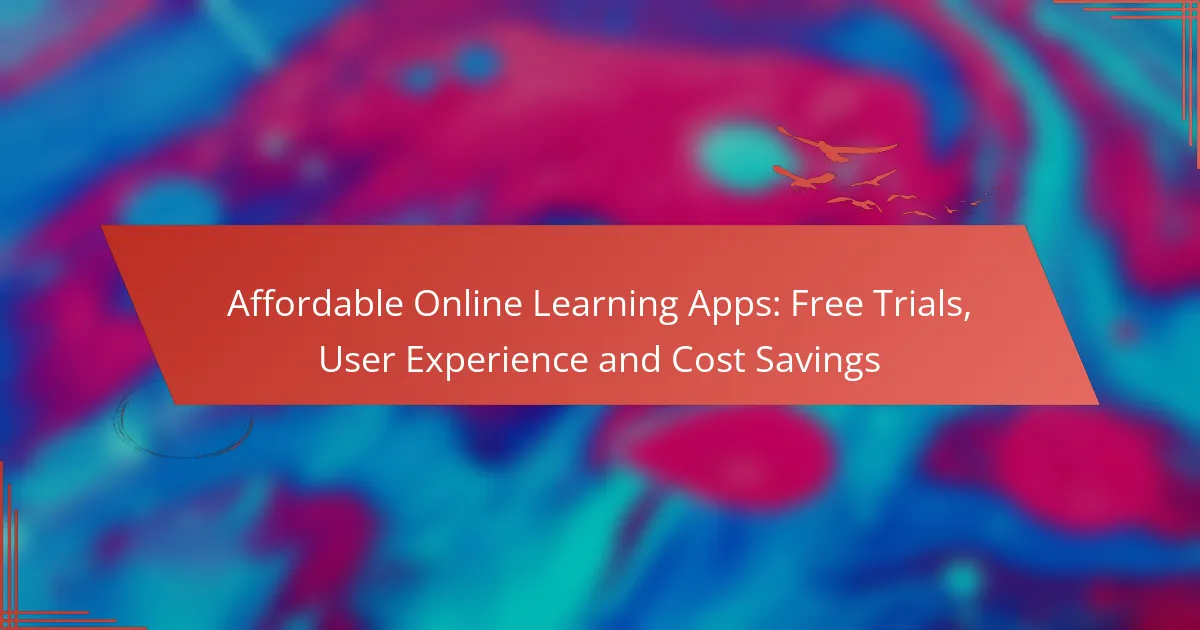AI learning apps are revolutionizing education by offering a range of affordable options designed to support low-income users. By employing various pricing models, these apps ensure that quality educational resources are accessible to everyone, regardless of their financial situation. Popular platforms like Khan Academy, Duolingo, Coursera, and Babbel exemplify this balance of cost, features, and accessibility, catering to diverse learning needs.

How Do AI Learning Apps Support Low-Income Users?
AI learning apps support low-income users by providing various affordable options and resources tailored to their financial constraints. These initiatives help ensure that everyone has access to quality educational tools, regardless of their economic background.
Subsidized access programs
Subsidized access programs offer reduced or free subscriptions to AI learning apps for low-income individuals. These programs often require proof of income or participation in government assistance programs, making education more accessible to those who need it most.
For example, some platforms may charge as little as 10-20% of their standard fees for eligible users, significantly lowering the barrier to entry for quality learning resources.
Free trials and freemium models
Many AI learning apps provide free trials or freemium models that allow users to access basic features without any cost. This approach enables low-income users to explore the app’s offerings before committing financially.
Freemium models often include essential features for free, with the option to upgrade for advanced tools. Users should evaluate which features are necessary for their learning needs to avoid unnecessary expenses.
Partnerships with educational institutions
Partnerships between AI learning apps and educational institutions can enhance accessibility for low-income users. Schools and universities may offer free or discounted access to these apps as part of their curriculum or support services.
For instance, a school may provide students with access to a premium AI learning app at no cost, ensuring that all students can benefit from advanced educational technology.
Community-driven initiatives
Community-driven initiatives often focus on providing resources and support for low-income users. These programs may include local workshops, tutoring sessions, or access to technology that facilitates learning.
Organizations may collaborate with AI learning app developers to create tailored programs that address specific community needs, ensuring that low-income users receive the support necessary to succeed in their educational pursuits.

What Are the Pricing Models for AI Learning Apps?
AI learning apps typically use various pricing models to cater to different user needs and budgets. Understanding these models can help users choose the best option for their learning goals and financial situation.
Monthly subscription fees
Monthly subscription fees are a common pricing model for AI learning apps, allowing users to pay a set amount each month for access to the platform. These fees generally range from around $10 to $30 per month, depending on the app’s features and content quality.
This model is ideal for users who want flexibility and the ability to cancel at any time. However, it can become costly over time compared to annual plans.
Annual membership discounts
Annual membership discounts offer users a reduced rate when they commit to a full year of access. Typically, these discounts can save users anywhere from 10% to 30% compared to monthly fees.
This option is beneficial for dedicated learners who plan to use the app long-term. Users should consider the upfront cost, which can be significant, but the savings can justify the investment.
Pay-per-use options
Pay-per-use options allow users to pay only for the specific features or content they access, making it a flexible choice for casual learners. Prices can vary widely, often ranging from a few dollars for individual lessons to higher amounts for specialized content.
This model is advantageous for those who want to try the app without a long-term commitment. However, users should be cautious, as costs can add up quickly if they frequently access premium content.
Tiered pricing structures
Tiered pricing structures provide multiple subscription levels, each offering different features and benefits. For example, a basic tier might include limited access, while higher tiers could offer advanced features, personalized learning paths, or additional resources.
This model allows users to choose a plan that best fits their needs and budget. However, it’s essential to evaluate whether the additional features in higher tiers are worth the extra cost before upgrading.

Which AI Learning Apps Offer the Best Value?
Several AI learning apps provide excellent value, balancing cost, features, and accessibility. Key options include Khan Academy, Duolingo, Coursera, and Babbel, each catering to different learning needs and budgets.
Khan Academy
Khan Academy is a free educational platform that offers a wide range of subjects, including math, science, and humanities. Its AI-driven personalized learning paths adapt to each student’s pace, making it suitable for learners of all ages.
Consider using Khan Academy if you’re looking for comprehensive resources without any financial commitment. The platform is particularly beneficial for students needing extra help or those preparing for standardized tests.
Duolingo
Duolingo is a popular language-learning app that uses gamification to engage users. It offers a free version supported by ads, while a premium subscription removes ads and provides additional features.
For those interested in learning a new language, Duolingo’s interactive approach makes it fun and effective. The app is particularly valuable for beginners, as it covers many languages and allows learners to progress at their own pace.
Coursera
Coursera partners with universities and organizations to offer online courses, many of which are free to audit. Paid options provide certificates and access to graded assignments, making it a flexible choice for professional development.
If you’re looking to enhance your skills or gain new qualifications, Coursera’s diverse course offerings can be a great investment. Keep an eye out for financial aid options that can help reduce costs for low-income learners.
Babbel
Babbel is a subscription-based language-learning app that focuses on conversation skills and practical vocabulary. It offers a structured curriculum tailored to different proficiency levels, making it suitable for serious learners.
While Babbel requires a monthly fee, its targeted approach can lead to quicker language acquisition. If you’re committed to learning a language, consider taking advantage of any trial offers to assess its fit for your learning style.

How Do AI Learning Apps Enhance Accessibility?
AI learning apps significantly enhance accessibility by providing personalized learning experiences that cater to diverse user needs. These applications leverage technology to break down barriers related to language, learning styles, and internet connectivity, making education more inclusive for everyone.
Multilingual support
Multilingual support in AI learning apps allows users to access content in their preferred language, which is crucial for non-native speakers. This feature often includes real-time translation and language options that adapt to the user’s proficiency level, enhancing comprehension and engagement.
For example, an app might offer lessons in English, Spanish, and Mandarin, enabling learners from different backgrounds to study comfortably. This flexibility can lead to better learning outcomes and increased participation in educational programs.
Adaptive learning technologies
Adaptive learning technologies tailor educational content to the individual learner’s pace and understanding. By analyzing user performance, these systems adjust the difficulty of tasks and suggest resources that align with the learner’s needs.
This personalized approach helps students grasp concepts more effectively, as they receive targeted support. For instance, if a student struggles with math, the app may provide additional practice problems and instructional videos focused on that topic.
Offline access features
Offline access features in AI learning apps ensure that users can continue their education without a constant internet connection. This is particularly beneficial in areas with limited connectivity, allowing learners to download lessons and resources for later use.
For example, a student can download a series of interactive lessons on their device and study them while commuting or in remote locations. This capability promotes continuous learning regardless of internet availability.
User-friendly interfaces
User-friendly interfaces are essential for making AI learning apps accessible to all users, including those with limited tech experience. Intuitive designs, clear navigation, and engaging visuals help users easily find and utilize the app’s features.
Apps that prioritize simplicity often include tutorials or guided tours to familiarize new users with functionalities. This approach reduces frustration and encourages consistent use, ultimately enhancing the learning experience.



